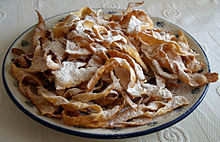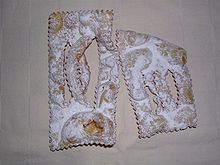- Angel wings
-
Angel wings are a traditional sweet crisp pastry made out of dough that has been shaped into thin twisted ribbons, deep-fried and sprinkled with powdered sugar. Traditionally present in several European cuisines, angel wings are known by many other names and have been incorporated into other regional cuisines (such as the United States) by immigrant populations. They are most commonly eaten in the period just before Lent, often during Carnival and on Fat Thursday, the last Thursday before Lent – not to be confused with "Fat Tuesday" (Mardi Gras), the day before Ash Wednesday. There is a tradition in some countries for husbands to give angel wings to their wives on Friday the 13th in order to avoid bad luck.[where?] Some believe that 13 is the Devil's number.
Contents
Alternate names
In the various national cuisines, angel wings are referred to as:
- Belarussian: хрушчы (chruščy) or фаворкі (favorki)
- French: bugnes
- German: Raderkuchen
- Hungarian: csöröge
- Croatian: krostole
- Italian: bugie, chiacchiere, crostoli, frappe, galani, sfrappole
- Lithuanian: žagarėliai
- Polish: chruścik, chruściki, chrust, chrusty, faworki
- Russian: хворост
- Swedish: klenäter
- Slovakian: fánka[1]
Variants by country
France
In France the fried pastry are made in central-eastern France, including Lyon and Saint-Étienne, and are closely related to beignets. Traditionally, Lyon cold meat shops sold bugnes just before Lent, due to their high fat content. They are also made in the home as a way of using surplus cooking fat, which would be wasted during Lent. More recently, bakeries make them, respecting more or less the tradition of Lent.
French bugnes varieties include crunchy bugnes and soft bugnes. The crunchy variety, known as "bugnes lyonnaises" ("Lyon bugnes"), are cooked in very hot oil with the dough spread out thinly and knotted once or twice. The soft variety, sometimes known as "pillows", are made with a thicker dough, which is rarely knotted.
Hungary
Hungarian csöröge are made from egg yolk, flour, a leavening agent, sugar, salt and cognac or brandy. They are deep fried and sprinkled with powdered sugar. They are traditional at weddings.[2]
Italy
Italian chiacchiere are eaten at Carnival time. Their various regional names include: frappe (a name shared with similar treats) in Rome; sfrappole in Emilia Romagna; bugie in Genoa; and galani or crostoli in Veneto and Friuli-Venezia Giulia, especially in the Triestino capital, Trieste. Many other regional names exist. Regional variations in the recipe include sprinkling with orange zest or using anisette wine as the alcoholic base.
Poland
Chruściki, chrusty, and faworki are the plural forms of the words chruścik, chrust, and faworek, respectively.
The Polish word "faworki" was the name reserved for colourful ribbons attached to either female or male clothing, especially ribbons given to medieval knights by their ladies. Etymologically the word "faworki" came to Poland from the French word faveur, meaning "grace" or "favour".
The Polish word "chrust" means "dry branches broken off trees" or "brushwood".[3] "Chruścik" is a diminutive of "chrust".
United States
In the United States, many ethnic bakeries in the cities of Cleveland, Chicago, and Detroit make angel wings, and they are especially popular during the holidays of Easter and Christmas. During those holidays, some bakeries require people to pre-order their angel wings.
See also
- List of fried dough foods
References
- ^ Slavic dictionary (Slovak). Retrieved June 5, 2010.
- ^ Clara Margaret Czegeny Helen's Hungarian Heritage Recipes Edition 3 Dream Machine Publishing, 2006 ISBN 0978025407, 9780978025403 Length 299 pages page 227
- ^ chrust Polish online dictionary (Polish). Retrieved November 25, 2009.
[[Category:Italian desserts]
Categories:- Mardi Gras food
- Polish desserts
- Lithuanian cuisine
- French pastry
- Culture of Rhône-Alpes
- Gastronomy of Rhône-Alpes
- Doughnuts
- Hungarian desserts
Wikimedia Foundation. 2010.


